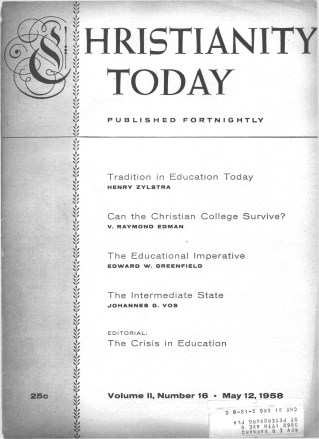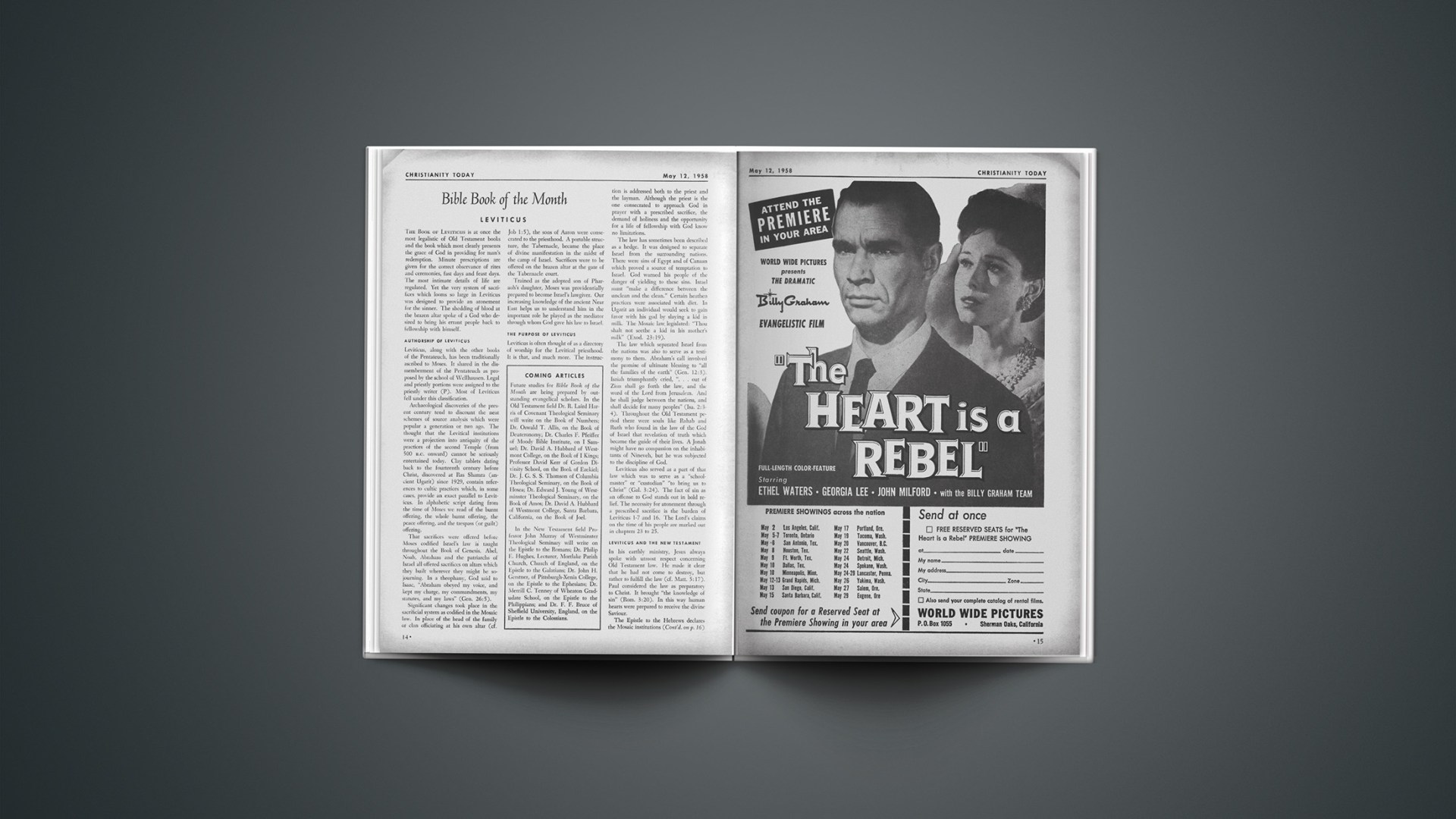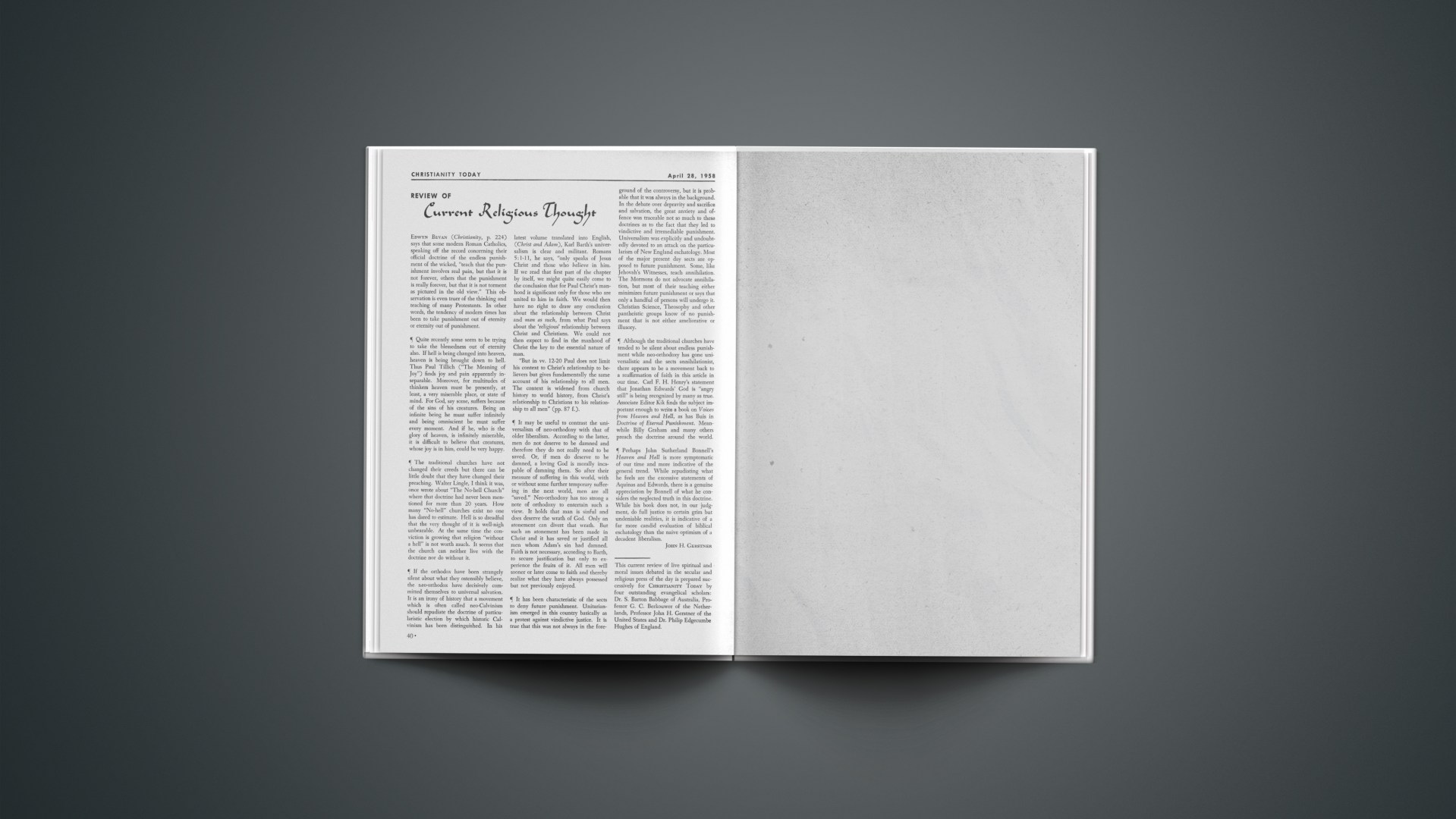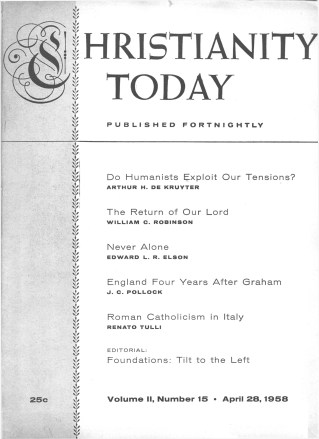THE SIN OF FLESH
No suburbanite could make the Manichean mistake. The American body is not evil! Indeed, there is only one sin of the flesh likely to arouse modern guilt feelings: the sin of the bulge. How the Psalmist could envy those whose eyes stood out with fatness is now hard to imagine. Ehud’s treatment of the king of Moab seems more understandable; what else can a fat man expect?
This widespread anxiety feels the pinch at this time of the year, for last summer’s wardrobe—in fact, any summer wardrobe—demands a more fashionable shape.
In the days when other fleshly sins were taken seriously, fasting and spiritual exercises were zealously practiced. Contemporary saints of physical culture urge similar drastic remedies. They rally the faithful with magazine homilies on eight-day diets. Photographs of their graceful deep-knee bends guide the struggles of those with less bounce and more ounces.
Such measures are for the stern. Others prefer the Ramadan plan: fast in the day and feast at night. But the ideal weightlifting scheme requires no exertion, permits gorging as usual, and gives astounding results in 10 days. It is, of course, a blend of chemistry and electronics. One smokes reducing cigarettes and eats reducing candy while relaxing the pounds away in a contour massage chair. To repeat the achievement, shut off the current and put on weight in the same chair!
With such electronic control of the flesh, guilt becomes nominal. Remaining tensions may be eased by a taste of religious TV, or dissipated on the new plug-in psychosomatic couch, where the soma is vibrated while the psyche is analyzed. Even the mortido drive is satisfied as one settles back in his own electric chair. The placidity of vibratory sedation is just this side of Nirvana.
EUTYCHUS
ADVENTISTS AND OTHERS
Harold Lindsell, in the March 31 issue (“What of Seventh-day Adventism?”), declared that I wrote Ellen G. White and Her Critics “to demonstrate the immaculate nature of Mrs. White’s teachings and life, defending her not only against all charges of plagiarism, lying, and breaking her word, but against doctrinal vagaries. I know of no SDA literature that hints that Mrs. White was ever wrong. This had led, and can only lead, to the notion that there is an intrinsic affinity between her writings and … the Bible.”
I am a bit startled to learn that this is what I set out “to demonstrate.” As my preface states, I set out to answer a specific list of charges against Mrs. White—charges which, if left unanswered would lead men to view her as either a psychopath or a crafty deceiver. I affirmed belief that she possessed the gift of the spirit of prophecy. But it never occurred to me to view her as “immaculate.” Indeed, to borrow Mr. Lindsell’s words, how could Adventists show any “affinity between her writings and those of the Bible” if we thus viewed her? I have never heard anyone claim that David, for example, was “immaculate” both in “teachings and life,” or that any prophet of the Bible ever expressed merely human thoughts. Elijah declared that he alone remained faithful, but his figures were 6,999 off.
However, in common with all loyal Christians, we like to focus on the inspired words and deeds of God’s prophets,—not on their finite limitations—and often with appropriate defense of these great men against skeptics, whose specialty is the finite side of the prophets. Adventists have ever believed that Mrs. White was a frail human being as well as one who received revelations from God. But we do not believe she was what her critics have charged. That is why I wrote my book.
Review and Herald
Washington, D. C.
• CHRISTIANITY TODAY has asked Dr. F. H. Yost, former professor of systematic theology at the Seventh-day Adventist Seminary, to reply in an early issue to published criticisms of that movement. In the meantime, representative excerpts chosen from a tidal wave of correspondence will be printed.—ED.
As for the writings of Mrs. White: Were you to read extensively in her works or only the volume Desire of Ages, you could not help but confess the writings of all other contemporary authors including your editors but chaff in comparison. Buena Park, Calif.
Harold Lindsell’s articles “What of Seventh-day Adventism?” are interesting and thought-provoking (CHRISTIANITY TODAY, Mar. 31 and Apr. 14, 1958). But his references to Christian Science are factually incorrect.
It would be entirely correct to say that Christian Science does not wholly agree with the evangelical concepts of traditional theology, but completely contrary to the facts to assert that Christian Science denies any of the basic tenets of Christianity as conceived by Christ Jesus and established by early Christians such as the Apostle Paul.…
Christian Science unequivocally accepts the divinity of the Christ, but it differentiates between Jesus as the son of man and Christ as the Son of God. It not only fully accepts Christ’s atoning work on Calvary, but teaches that cross-bearing today—the sacrificing of a false material sense of self, illustrated by Christ Jesus for all mankind throughout all times—is the only way to reach the understanding and demonstration of man’s spiritual selfhood in God’s perfect image and likeness.
Christian Science fully accepts the Virgin Birth as evidence of the spiritual conception of the child Jesus.
May I ask your further indulgence in order to correct a misconception of the teaching of Christian Science regarding “death” (Feb. 3, 1958, issue)? Contrary to the assertion in that issue, Christian Science does not deny the incident common to human experience termed “death.” We understand, however, that this experience does not terminate the individual life of man in God’s image, for we accept the Bible teaching of the immortality, eternality and indestructibility of God’s man. The words “died” and “death” appear in Christian Science periodicals where the context requires them, but the term “passed on” we consider to be more accurate.
Christian Science Com. on Publication
Washington, D. C.
• By the divinity and atonement of Christ, Christian Science means—as Mr. Douglass implies—something quite different from the doctrine that God has become uniquely incarnate in Jesus of Nazareth and that the Redeemer’s work on the Cross expiates sin and propitiates divine wrath. In Science and Health Mary Baker Eddy writes: “Final deliverance from error is not reached … by pinning one’s faith without works on another’s vicarious effort” (p. 22).… “The Christian … virtually unites with the Jew’s belief in one God, and recognizes that Jesus Christ is not God, as Jesus himself declared, but is the Son of God” Cp. 361).… “Evil has no reality. It is neither person, place, nor thing, but is simply a belief, an illusion of material sense” (p. 71).—ED.
Mr. Lindsell knows nothing about Christian Science.…
South Bend, Ind.
GOSPEL OF THE CATHEDRALS
I have just read … “Meditation” (Mar. 31 issue), a poem purporting to reflect what … Hough calls the godlessness of a cathedral. The sentiment expressed is not as lofty as “Murder in a Cathedral,” nor does the poem reflect the depth of feeling one would have on entering the Cathedral of the Holy Wisdom in Istanbul where Christians sang, “Lord, now lettest thou thy servant depart in peace,” and then had their throats cut. Does Mr. Hough know that Coventry Cathedral is rising again and that he can kneel there to thank God that the Nazi airplanes did not have the last word? There is a fiery gospel written into the bulwark of cathedrals.
St. George’s Rectory
Central Falls, R. I.
God can get completely lost in the outward forms and creature comforts of a wealthy church; but such a tragedy is not found only in cathedrals, but also in evangelical temples (even in Madison Square Garden) where sinners also go and “nod to God,” shutting their ears to God’s Word.
Grace Episcopal Chapel
Wyandotte, Mich.
It is so typical of his keen wit.…
First Baptist Church
Salisbury, Mo.
INTERPRETATION DOUBTED
In … “Gone with the Resurrection” (Mar. 31 issue) are found the words, “Sorry, Father, that I was angry and impatient”.… They seem to make our Lord confess the sins of anger and impatience.…
Pomona, Calif.
The words … brought me up short with a shock like a cold bath.
Daytona Beach, Fla.
I would like to record my astonishment at what I consider a bizarre interpretation of our Lord’s weeping at the grave of Lazarus. Has Mr. Seerveld never experienced the tenderness of earthly associations and the sorrow that comes when they are broken? And to make the absurd statement that “tears are actually out of place” when a Christian dies, is sheer nonsense.
The First United Presbyterian Church
Columbus, Ohio
If it were necessary for Jesus to apologize to the Father on route to the grave of Lazarus one is prompted to ask, “Who did sin, this man or his parents.…?”
With respect to his rigid interpretation, how literal should we become when we say, “Let the dead bury the dead?”
We have rejoiced in the opportunity of presenting the claims of Christ at countless memorial or funeral services. In doing so we often reach an element of humanity which cannot be reached with the claims of Christ in any other way.
First Baptist Church
Oneonta, N. Y.
CHARITABLE CONSTRUCTION
The comments which you made at the close of your editorial on the Resurrection (Mar. 31 issue) … were very comforting and helpful.…
The first statement … by Dr. Ockenga [“Far from being an historical event two thousand years removed from us, … the Resurrection is a contemporaneous occurrence.…”] … troubled me very much.… The most charitable construction that can be put upon this thought is that it does not express exactly what Dr. Ockenga wanted to say. I find it very hard to believe that he would not hold that the Resurrection was an historical occurrence of 2000 years ago.
Westminster Theological Seminary
Philadelphia, Pa.
Your March 31st number … had very significant and helpful articles on the resurrection of Jesus Christ.
Schenectady, N. Y.
DIGNITY OF MAN
May I tell you how pleased I was with the March 31st issue.… I thought … “The Problem of Prejudice” was one of the finest that I have read in a long time. It was as though he were skinning an onion as layer by layer he reached into the center of this problem of prejudice which, at bottom after all, is a failure to acknowledge and recognize the essential dignity of man that derives from his creation.
Anti-Defamation League of B’nai B’rith
New York, N. Y.












